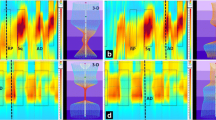Abstract
PURPOSE: The effects of biofeedback (BF) on pain relief and anorectal physiology in patients with levator ani syndrome (LAS) were prospectively studied. METHOD: Sixteen consecutive patients (9 men, 7 women; mean age, 50.1 (range, 39–66) years) with LAS were treated with BF from July 1993 to October 1995. Mean duration of pain was 32.5 (standard error of the mean, 6.7) months. All underwent a full course of BF using a manometric balloon technique. Mean follow-up was 12.8 (standard error of the mean, 2.6) months. Pain score and anorectal physiology tests were administered prospectively by an independent observer before and after BF. RESULTS: After BF, the pain score was significantly improved (before BF: median, 8 (range, 6–10); after BF: median, 2 (range, 1–4);P < 0.02). Analgesic requirements were also significantly reduced (all 16 patients needed nonsteroidal anti-inflammatory drugs (NSAID) before BF; only two patients needed NSAID after BF;P <0.03). There were no significant changes to the anorectal physiology parameters after BF. To date, there have been no side effects or regressions. CONCLUSION: Although BF had a negligible effect on anorectal physiologic measurements in LAS, it was effective in pain relief, with no side effects.
Similar content being viewed by others
References
McGivney JQ, Cleveland BR. The levator syndrome and its treatment. South Med J 1965;58:505–10.
Thiele GH. Coccygodynia: cause and treatment. Dis Colon Rectum 1963;6:422–36.
Billingham RP, Isler JT, Friend WG, Hostetler J. Treatment of levator syndrome using high-voltage electrogalvanic stimulation. Dis Colon Rectum 1987;30:584–7.
Sohn N, Weinstein MA, Robbins RD. The levator syndrome and its treatment with high-voltage electrogalvanic stimulation. Am J Surg 1982;144:580–2.
Hull TL, Milsom JW, Church J, Oakley J, Lavery I, Fazio V. Electrogalvanic stimulation for levator syndrome: how effective is it in the long term? Dis Colon Rectum 1993;36:731–3.
Reilly WT, Pemberton JH. Levator spasm and pelvic pain. Perspect Colon Rectal Surg 1994;1–5.
Grimaud J-C, Bouvier M, Naudy B, Guien C, Salducci J. Manometric and radiologic investigations and biofeedback treatment of chronic idiopathic anal pain. Dis Colon Rectum 1991;34:690–5.
Ger GC, Wexner SD, Jorge JM,et al. Evaluation and treatment of chronic intractable rectal pain—a frustrating endeavor. Dis Colon Rectum 1993;36:139–45.
Grant SR, Salvati EP, Rubin RJ. Levator syndrome: an analysis of 316 cases. Dis Colon Rectum 1975;18:161–3.
Salvati EP. The levator syndrome and its variant. Gastroenterol Clin North Am 1987;16:71–8.
Nicosia JF, Abcarian H. Levator syndrome: a treatment that works. Dis Colon Rectum 1985;28:406–8.
Thiele GH. Tonic spasm of the levator ani, coccygeus and piriformis muscles: its relationship to coccygodynia and pain in the region of the hip and down the leg. Trans Am Proc Soc 1936;37:145–5.
Ho YH, Goh HS. The current value of anorectal physiology and biofeedback in clinical practice. Asian J Surg 1995;18:244–51.
Neill ME, Swash M. Chronic perianal pain syndromes. In: Henry MM, Swash M, eds. Coloproctology and the pelvic floor. 2nd ed. Oxford: Butterworth-Heinemann, 1992:449–54.
Author information
Authors and Affiliations
About this article
Cite this article
Heah, SM., Ho, YH., Tan, M. et al. Biofeedback is effective treatment for levator ani syndrome. Dis Colon Rectum 40, 187–189 (1997). https://doi.org/10.1007/BF02054986
Issue Date:
DOI: https://doi.org/10.1007/BF02054986




